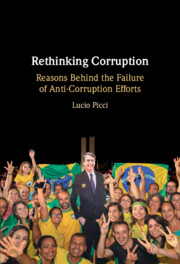Book contents
- Rethinking Corruption
- Rethinking Corruption
- Copyright page
- Dedication
- Contents
- Figures
- Preface
- Part I Laying the Groundwork
- Part II Three Case Studies
- Part III Rethinking Corruption
- 9 Legal Corruption and Other Societal Geographies
- 10 A Problem of Control
- 11 Fighting Corruption, Fighting for Corruption
- 12 Conclusions
- References
- Index
10 - A Problem of Control
Corruption Is a Tool of Government
from Part III - Rethinking Corruption
Published online by Cambridge University Press: 27 February 2024
- Rethinking Corruption
- Rethinking Corruption
- Copyright page
- Dedication
- Contents
- Figures
- Preface
- Part I Laying the Groundwork
- Part II Three Case Studies
- Part III Rethinking Corruption
- 9 Legal Corruption and Other Societal Geographies
- 10 A Problem of Control
- 11 Fighting Corruption, Fighting for Corruption
- 12 Conclusions
- References
- Index
Summary
This chapter presents the conclusion that corruption is a tool of government. The cases of Brazil and of Russia provide examples of how corruption can function as a tool of government by providing powerful incentives, both positive and negative, that help maintain elite cohesion and implement policies. These cases demonstrate how corruption can become a trap, as it may be the only viable solution for maintaining control in government, despite its deficiency as a tool. The differences between Russia and Brazil, and other cases that I consider, emphasize the importance of context-dependent information and of case studies.
- Type
- Chapter
- Information
- Rethinking CorruptionReasons Behind the Failure of Anti-Corruption Efforts, pp. 192 - 206Publisher: Cambridge University PressPrint publication year: 2024

